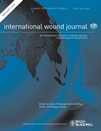Definition of infection in chronic wounds by Dutch nursing home physicians
ABSTRACT
This study investigated the number and type of chronic wounds actually treated by Dutch nursing home physicians (NHPs). It was also the goal to know how many of the treated chronic wounds they considered infected. The NHPs were asked to choose and rank their top five out of several provided criteria for chronic wound infection. After this, the ranking was compared with the choices an international multidisciplinary Delphi group of wound experts made in 2005. A cross-sectional descriptive survey was conducted using the information from a self-reported questionnaire in a representative sample of Dutch NHPs. About 361 NHPs (25%) were sent a questionnaire. Of the 361 physicians, 139 (38.5%) filled in and returned the questionnaire of which 121 were valid. Of the NHPs, 73.5% actually treated at least one chronic pressure ulcers (PU), whereas 26.5% did not treat any. All NHPs treated three or less chronic post-surgical wounds, whereas 68.4% treated none. Chronic venous leg ulcers, arterial ulcers and diabetic ulcers scored infrequently and less than the other two sorts of chronic wounds. Of the Dutch NHPs, 53% considered that none of the PU infected. The other chronic wounds were judged far less frequently to be infected. Dutch NHPs appeared to use more ‘traditional’ criteria such as ‘puss/abscess' and ‘malodour’ to identify infection and did not change their criteria by wound type. According to this study, NHPs do not frequently see many chronic wounds. The most frequent type of wounds treated was PU. For NHPs, the identification of infection of all types of chronic wounds is difficult. The use of criteria that is not in line with consensus documents may lead to ineffective treatment and even seriously damage patients: the clinical identification of infection is still dependent on experts' opinion. Further research on triggers for the suspicion of wound infection and the development of an evidence-based guideline is necessary.




